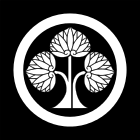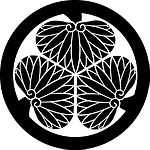Murakami Domain
Murakami Domain (村上藩 Murakami-han) was a Japanese domain of the Edo period. It was associated with Echigo Province in modern-day Niigata Prefecture.[1]
In the han system, Murakami was a political and economic abstraction based on periodic cadastral surveys and projected agricultural yields.[2] In other words, the domain was defined in terms of kokudaka, not land area.[3] This was different from the feudalism of the West.
List of daimyo
The hereditary daimyo were head of the clan and head of the domain.
- Yorikatsu[5]
- Tadakatsu
- Hori clan, 1618-1644 (tozama; 100,000 koku)[1]
- Naoyori[5]
- Naotsugu
- Naosada
-
 Honda clan, 1644-1649 (fudai; 100,000 koku)[1]
Honda clan, 1644-1649 (fudai; 100,000 koku)[1]
-
 Matsudaira (Echizen) clan, 1649-1667 (fudai; 100,000 -> 150,000 koku)[6]
Matsudaira (Echizen) clan, 1649-1667 (fudai; 100,000 -> 150,000 koku)[6]
- Naonori[5]
-
 Sakakibara clan, 1667-1704 (fudai; 150,000 koku)[7]
Sakakibara clan, 1667-1704 (fudai; 150,000 koku)[7]
- Naoyori
- Masatomo
- Masakuni
-
 Honda clan, 1704-1709 (fudai; 150,000 koku)[8]
Honda clan, 1704-1709 (fudai; 150,000 koku)[8]
- Tadayoshi
- Tadataka
- Tadayoshi
- Ōkochi clan, 1710-1717 (fudai; 72,000 koku)[9]
- Terusada
-
 Manabe clan, 1717-1720 (fudai; 50,000 koku)[10]
Manabe clan, 1717-1720 (fudai; 50,000 koku)[10]
- Akifusa
- Akitoki
-
 Naitō clan, 1720-1868 (fudai; 50,000 koku)[11]
Naitō clan, 1720-1868 (fudai; 50,000 koku)[11]
See also
References

- ↑ 1.0 1.1 1.2 "Echigo Province" at JapaneseCastleExplorer.com; retrieved 2013-4-7.
- ↑ Mass, Jeffrey P. and William B. Hauser. (1987). The Bakufu in Japanese History, p. 150.
- ↑ Elison, George and Bardwell L. Smith (1987). Warlords, Artists, & Commoners: Japan in the Sixteenth Century, p. 18.
- ↑ Papinot, Jacques Edmond Joseph. (1906). Dictionnaire d’histoire et de géographie du Japon; Papinot, (2003). "Murakami" at Noblaire du Japon, p. 38; Murakami Castle 村上城 at JCastle.info; retrieved 2013-4-7.
- ↑ 5.0 5.1 5.2 Murakami Castle 村上城 at JCastle.info; retrieved 2013-4-7.
- ↑ Papinot, (2003). "Matsudaira (Echizen)" pp. 29-30; retrieved 2013-4-7.
- ↑ Papinot, (2003). "Sakakibara" at p. 51; retrieved 2013-4-7.
- ↑ Papinot, (2003). "Honda" at pp. 10-11; retrieved 2013-4-7.
- ↑ Papinot, (2003). "Ōkochi" at 46; retrieved 2013-4-7.
- ↑ Papinot, (2003). "Manabe" at p. 29; retrieved 2013-4-7.
- ↑ Papinot, (2003). "Naitō" at pp. 39-40; retrieved 2013-4-7.
External links
- "Murakami" at Edo 300 (Japanese)
| ||||||||||||||||||||||||||||||||||||||